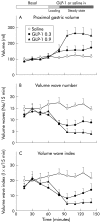Effects of glucagon-like peptide-1(7-36)amide on motility and sensation of the proximal stomach in humans
- PMID: 11839712
- PMCID: PMC1773139
- DOI: 10.1136/gut.50.3.341
Effects of glucagon-like peptide-1(7-36)amide on motility and sensation of the proximal stomach in humans
Abstract
Background: Glucagon-like peptide-1(7-36)amide (GLP-1) retards gastric emptying, reduces food intake, and inhibits antroduodenal and stimulates pyloric motility.
Aims: To assess the effects of synthetic GLP-1 on fundus tone and volume waves, gastric compliance, and perception of gastric distension.
Subjects: Eleven healthy male volunteers.
Methods: Background infusions were saline, or GLP-1 at 0.3 or 0.9 pmol/ kg/min on separate days in random order. Interdigestive fundus motility was recorded by barostat (maximum capacity of intragastric bag 1200 ml) during basal and peptide periods of 60 minutes each. Thereafter stepwise isobaric distensions were performed with ongoing peptide infusion, and gastric sensation was scored.
Results: Low and high loads of GLP-1 induced physiological and supraphysiological plasma immunoreactivities, respectively. GLP-1 dose dependently diminished fundus tone (162.9 (15.0) and 259.5 (17.2) v 121.1 (6.0) ml with saline; p<0.0001). It greatly reduced volume waves and total volume displaced by these events (p<0.0001). Gastric compliance derived from isobaric distension rose in a dose related manner (42.6 (5.5) and 63.6 (7.7) v 27.0 (3.5) ml/mm Hg; p=0.0004) with a concomitant reduction of the pressure at half maximum bag volume (6.4 (0.4) and 5.5 (0.4) v 7.2 (0.1) mm Hg; p<0.0001). GLP-1 did not change perception of isobaric distension but reduced the perception score related to corresponding bag volume (p<0.0001).
Conclusions: GLP-1 is a candidate physiological inhibitory regulator of fundus motility. It allows the stomach to afford a larger volume without increase in sensation.
Figures




References
-
- Eissele R, Göke R, Willemer S, et al. Glucagon-like peptide-1 cells in the gastrointestinal tract and pancreas of rat, pig and man. Eur J Clin Invest 1992;22:283–91. - PubMed
-
- Hoyt EC, Lund PK, Winesett DE, et al. Effects of fasting, refeeding, and intraluminal triglyceride on proglucagon expression in jejunum and ileum. Diabetes 1996;45:434–9. - PubMed
-
- Byrne MM, Pluntke K, Wank U, et al. Inhibitory effects of hyperglycaemia on fed jejunal motility: potential role of hyperinsulinaemia. Eur J Clin Invest 1998;28:72–8. - PubMed
-
- Fehmann HC, Göke R, Göke B. Cell and molecular biology of the incretin hormones glucagon-like peptide-1 and glucose-dependent insulin releasing polypeptide. Endocr Rev 1995;16:390–410. - PubMed
Publication types
MeSH terms
Substances
LinkOut - more resources
Full Text Sources
Medical
